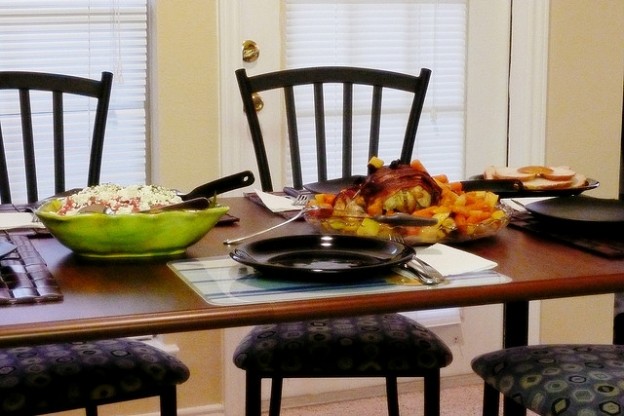
Photo: ecooper99/Flickr
Anne Fishel is an Associate Clinical Professor of Psychology at the Harvard Medical School and Director of Family and Couples Therapy at Massachusetts General Hospital. Most recently, she helped launch The Family Dinner Project, a collaborative, team-led organization committed to helping families and communities make mealtime more meaningful, and therefore more healthful on many levels.
Talking about family dinners is a focus of Anne’s work with the families she treats in her private practice and with the psychiatry residents she trains to work with families. Below, she discusses the physical space and settings of family dinners, and the collective impact on social dynamics and conversation.
What happens in your family?
Anne K. Fishel, Ph.D.
The Family Dinner Project
As a family therapist I am interested in context—why is a child seen as bossy at home but not at school? What allows a couple to have a lively conversation in a restaurant on Saturday night, but not in their own kitchen?
In my work with The Family Dinner Project, I encourage families to have more dinners with one another, and part of my strategy is to look for the elements of dinner that are playful and easy to change. Context is a prime one. If you change the seating or set the table with care, maybe even with flowers and candles, a new mood is created, and a new conversation may develop. This is also why, as a family therapist, I encourage my clients to sit in different seats in my office: perspectives can change when you see the world from a different vantage point.
At home, my young adult sons would much rather crowd around our too-small kitchen table for dinner than let their 6-foot-plus frames sprawl and spill around our more spacious dining room table. It’s not just the smaller size that feels cozier, but eating in the kitchen feels homier than eating in the dining room, which is where guests eat, not sons reclaiming their places at the regular family table. What’s more, my sons always tuck into their customary seats around the table — no matter how long they’ve been away.
When I talk to other families, most tell me the same thing: each family member sits in the same chair night after night. No one can quite remember how these decisions were made. But, in most families, it is considered a subversive act to claim a seat that isn’t yours. In my husband’s family, the girls sat on one side of the table, nearer the stove, so that they could spring up to get more food, while the boys sat on the far side. As with most rectangular tables, the parents sat at either end, connoting higher status as heads of the table.
But sitting on chairs around a table isn’t a universal custom. Continue reading →









 I like that these egg rolls are vegetable filled, light because they’re baked, and purportedly “a cinch to make.” It means they meet all of my criteria for a mid-week meal: healthy, fast, tasty. And they look fun to make — fun for me, fun for my kids. I recognize this is a beginner’s stance to a sophisticated cuisine. But, the way I figure it, what better way to introduce them to the cuisine that’s connected to the Year of the Dragon and complement classroom learning with a food experience. It’s a start. Hopefully, an auspicious one!
I like that these egg rolls are vegetable filled, light because they’re baked, and purportedly “a cinch to make.” It means they meet all of my criteria for a mid-week meal: healthy, fast, tasty. And they look fun to make — fun for me, fun for my kids. I recognize this is a beginner’s stance to a sophisticated cuisine. But, the way I figure it, what better way to introduce them to the cuisine that’s connected to the Year of the Dragon and complement classroom learning with a food experience. It’s a start. Hopefully, an auspicious one!
